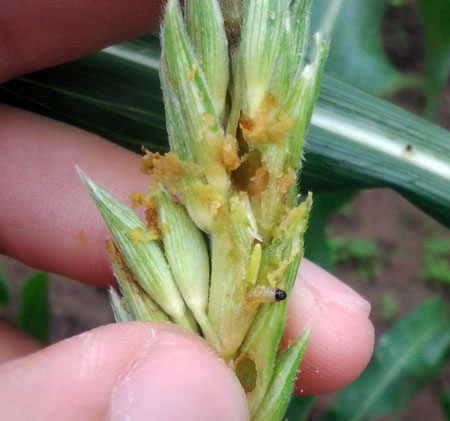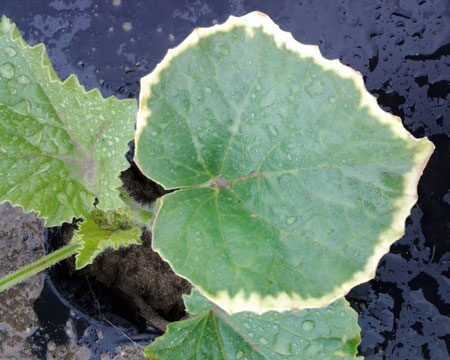Saginaw Bay area vegetable regional report – June 25, 2014
Over 40 hours of leaf wetness is making optimal conditions for disease spread.
The rainfall and growing degree day (GDD) base 50 degrees Fahrenheit accumulations as of June 25, 2014, from Michigan State University Enviro-weather stations at the following Bay and Thumb area vegetable growing regions are as follows:
- Romeo: 10.28 inches, 806.4 GDD
- Lapeer: 11.38 inches, 806.9 GDD
- Frankenmuth: 11.6 inches, 816 GDD
- Munger: 13.8 inches, 825.8 GDD
- Linwood: 11.97 inches, 729.3 GDD
Continual rain over the last week has made conditions ripe for disease in some areas, especially if 40 or more hours of continual leaf wetness have occurred. Bacterial diseases spread from water splashing, and many fungal pathogens need moist conditions to sporulate. Symptoms may not occur until seven to 14 days down the road, and then it may be too hard to control. Michigan State University Extension advises that now is the time for preventative fungicide applications. Read the Michigan State University Extension article, “Correct diagnosis is the first step to effective disease management,” by Lina Rodriguez Salamanca for a guide to sending plant samples to the MSU Diagnostic Services lab.
Slugs and snails also flourish in these conditions. Work by Rufus Isaacs in strawberry fields found that Deadline Bullets and Sluggo are two good products for control. Smartweeds, pepperweeds, and shepherd’s purse have been putting pressure on vegetable growers across the state.
In my Michigan State University Extension visits to the major Macomb, Lapeer, and Bay county vegetable areas, my best estimates of crop progress are below.
The earliest-planted sweet corn tassels emerged this week, and corn borer has already found them. I have captured two European corn borers in Macomb County.

European corn borer damage to a fresh sweet corn tassel. Photo credit: Ben Phillips, MSU Extension
Diamondback moth has been spotted in Macomb County in cabbages and greens. These caterpillars are tiny, and very active when harassed. They make tiny silk cocoons on the leaves. Treat when more than 30 percent of plants show signs of caterpillars and feeding damage prior to the cupping stage. Once the plants start cupping, the threshold gets tighter to 20 percent infestation. Between heading and harvest the threshold becomes 10 percent infestation. B.t. works well on all three species of cabbage caterpillars, i.e., cabbage whites, diamondback moth, cabbage looper, and the thresholds are the same.
In lettuce, harvesting of transplants has begun, and direct-seeded crops are being thinned and treated for Sclerotinia.
In carrots, aster leafhoppers are being found more frequently around the state, and their infectivity for aster yellows disease is increasing. I found many when sweeping the field margins in Lapeer County, and will be sending them to campus for infectivity analysis today.
Onion thrips have not reached threshold, and this recent rain and cooler temps will set them back.
Colorado potato beetle can be found now as adults and larvae in potatoes. Cultivating row middles and hilling the potatoes can knock back weeds and potato beetle eggs/larvae in the same process.
In string, snap, bush, and wax beans, field snap beans are near harvest in Saginaw County.
In melons and summer squash, some melon plantings are experiencing salt burn from excess copper or fertilizer applications. They are more vulnerable to this than other vine crops, but this should not affect yield if the problem is localized. Powdery mildew has been spotted in Southeast Michigan, and bacterial foliar diseases have been spotted in Saginaw County. This wet weather warrants some preventative fungicide action.

Salt burn in melons. Photo credit: Ben Phillips, MSU Extension
In tomatoes and peppers, if you have received 40 plus hours of leaf wetness, preventatively treat for bacterial diseases. In slicing cucumbers, harvest is underway in greenhouses. In pickling cucumbers, 50 to 60 percent are seeded in the Saginaw and Bay area. Downy mildew has not been confirmed in the Midwest yet, and spore traps in the Southeast and Bay area have not captured significant numbers. In table beets, radishes, turnips, and celery root, red beets are going to be ready soon. Celery root is all in.
In winter squash and pumpkins, seagulls have been a problem on direct seeded pumpkins in Saginaw and Bay counties. They are quick learners and communicators, and are attracted to places where humans have been working soil, because they unearth worms. Presumably, they will opportunistically feed on fresh seeds as well. I have observed that when a seed has already started to sprout they will leave it alone. Overseeding and/or covering can help ensure a good stand. They only need to be protected for a couple days.



 Print
Print Email
Email
